Reavers of Midgard is a heavy euro game about surprisingly generous Vikings!
Reavers of Midgard is the sequel to Champions of Midgard, a surprise hit from 2015 that is fun in its own right, but which really requires both of its add-on packs to really shine. Reavers aims to provide a heavier, more complete experience out of the box, and following a successful Kickstarter campaign, we’ve been sent a copy of the retail version to review.
Upon opening the box for Reavers of Midgard, it’s hard not to feel overwhelmed by the volume of material contained within. The manual isn’t the problem here since it’s actually quite brief (and, as it turns out, quite poorly written) but the number of decks of cards, dice and the volume of tokens is staggering.
Thankfully, upon laying out the board and assessing how the game is set up, you’ll learn that Reavers of Midgard isn’t as complex as it looks. The board is intensely busy and very attractive to look at, but by comparing the backs of each deck of cards with the obviously placed deck locations, you’ll know exactly where you’re going to put each one. There’s no complex shuffling or loading of decks either — you just shuffle every single one and place the decks out, then draw a number of cards based on player count.
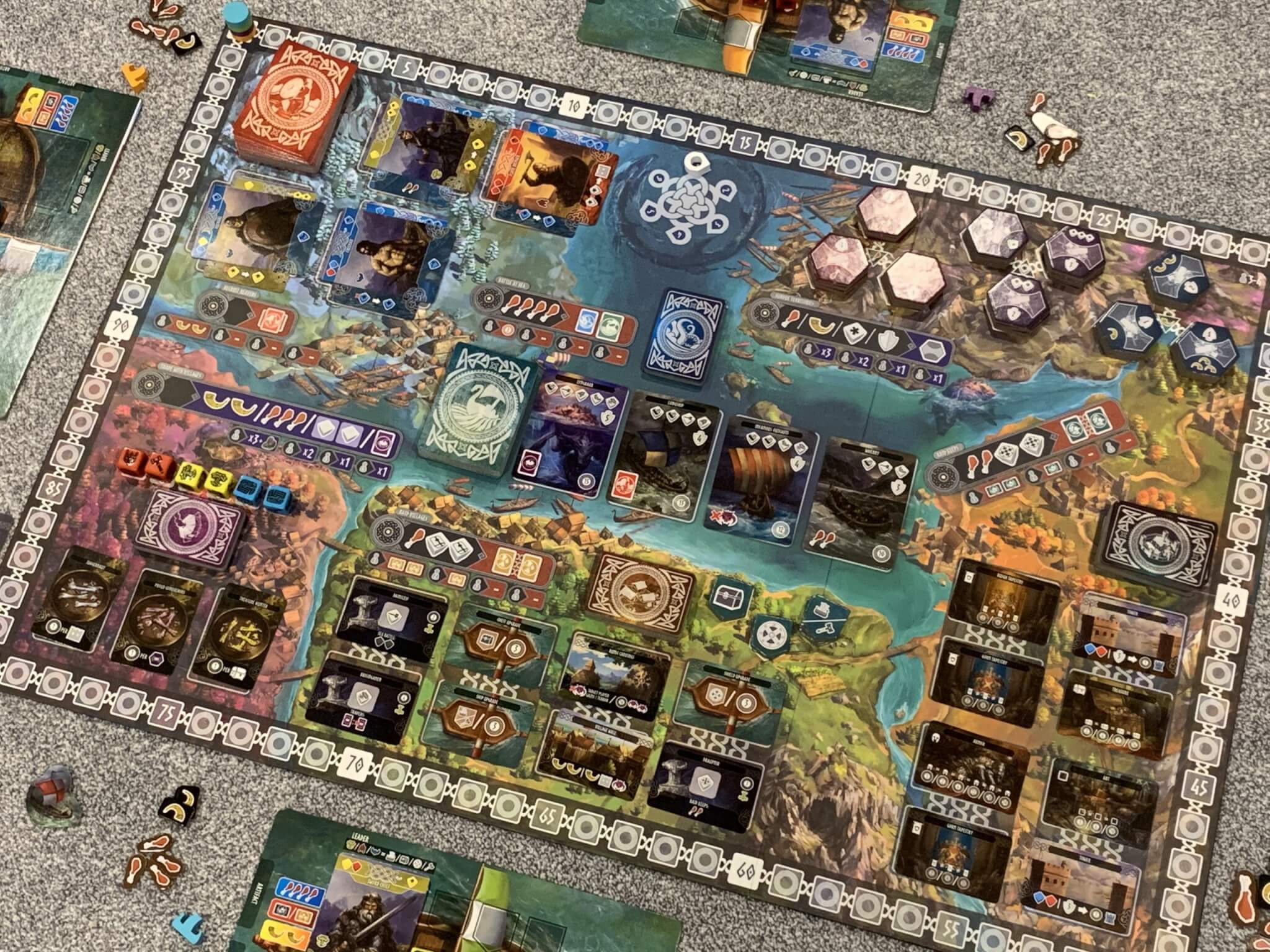
Each player receives a player board (all of which are the same) and then takes two of the Reaver cards, drawing the dice shown in the top left of each of them. There are then a number of other things to do — handing out tokens to each player, loading the territory tiles onto the board, rolling a few dice to place in the village location and that kind of thing. When all is said and done, your first game might take about twenty minutes to set-up, but each future game will be maybe ten minutes at most.
One thing to note here is that whilst Reavers of Midgard is similar in theme to the original Champions of Midgard and shares similarities with it, the two games are very different both in terms of gameplay style and weight. Champions is a lighter game with more luck involved, whilst Reavers is actually a very thoughtful game that has a lot of emergent depth to it and many, many valid strategies.
On that note, let’s talk about what you’ll be doing in Reavers of Midgard. First and foremost, the object of the game is to score Glory Points, which, by their usual name, would simply be called Victory Points. These points are tracked around the edge of the board as the game goes on, but there are also several things that score during the end game and let me tell you, Reavers is a very high scoring game. Scores in excess of 150 points are not uncommon, and close to 200 will often be the winning score.
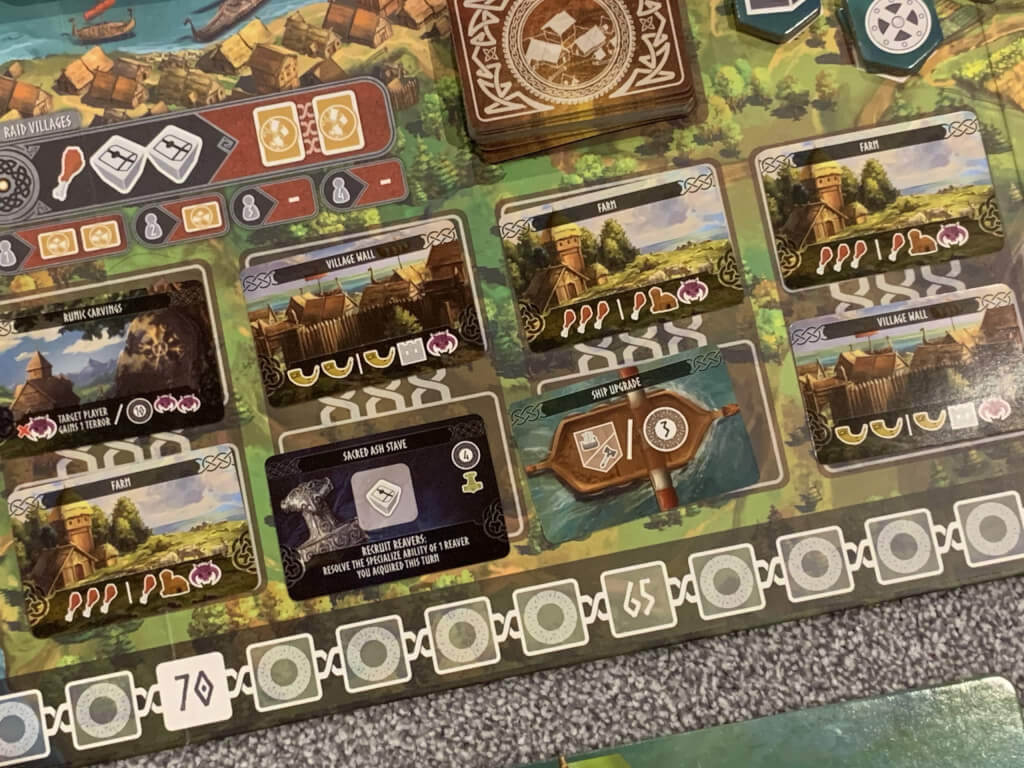
To achieve Glory Points, players have a literal smorgasbord of options, with almost everything you do scoring points either immediately, at the end of the current round or during the end game — sometimes even scoring in two or three of those phases independently. Without listing the possibilities exhaustively, players will recruit reavers, capture walls and towers, conquer territories, defeat monsters or other creatures, raid villages, collect tapestries or treasure, upgrade their ship and… well, that’s all I can remember. Oh, and completing sagas is a big one too.
In gameplay terms, the method for scoring these points is simple, and Reavers feels very much like a euro game rather than being close to a dice game as per its predecessor. On the downside, where Champions of Midgard had a simple loop of preparing for a voyage and then deciding to attack a nearby enemy or a distant one, Reavers is nowhere near as straightforward.
The result is that Reavers is probably the better game if you like a heavier game and can see your way through the fog of possible point-scoring opportunities that it presents, whilst Champions still offers a cleaner, more immediate set of choices that players of any experience level will be able to fathom their way through.
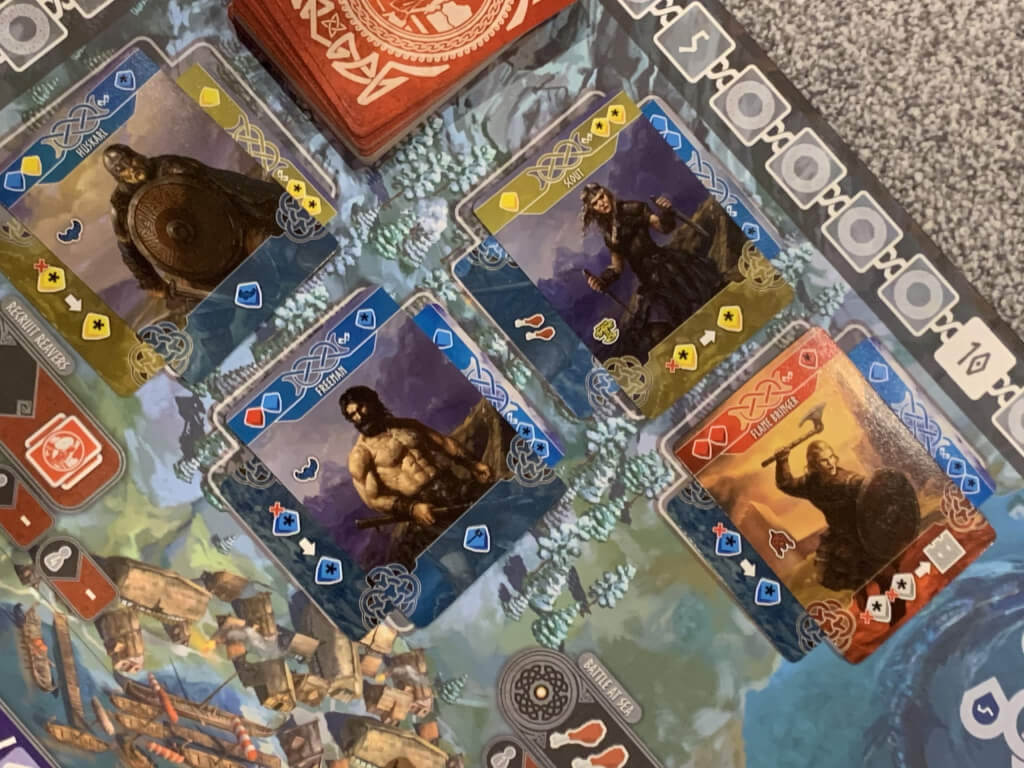
Anyway, with that said, let’s look at a few examples of the different action spaces, and learn how each game plays out. First of all, you should know that Reavers of Midgard takes place over six rounds of play, with each round comprising of exactly four turns, regardless of the player count. In a two-player game, each player has two ship pawns and will use them to take two actions, whilst at four players, each player has one ship pawn and will take one action. At three players, a bonus ship token is passed from player to player, allowing that player alone to take a second action each round.
So, one turn per round, per player, right? Sounds kind of boring and limiting. Well, it’s not, which is simply because Reavers of Midgard uses a follow-on mechanic that enables potentially up to all four players to take the action chosen by the active player, albeit at a declining level of power for each player based on how far away from the starting player they are. Let me explain that a bit more with a couple of examples.
Let’s say that the active player places their boat on the Recruit Reaver space, allowing them to choose one pair of reaver cards from the display. The first player doing so will also take a bonus of two favour tokens, whilst each other player may simply take another pair of reavers or rest. If they take a pair of reavers, then they can do so but without receiving a bonus, whilst if they rest, they simply take two food from the supply.
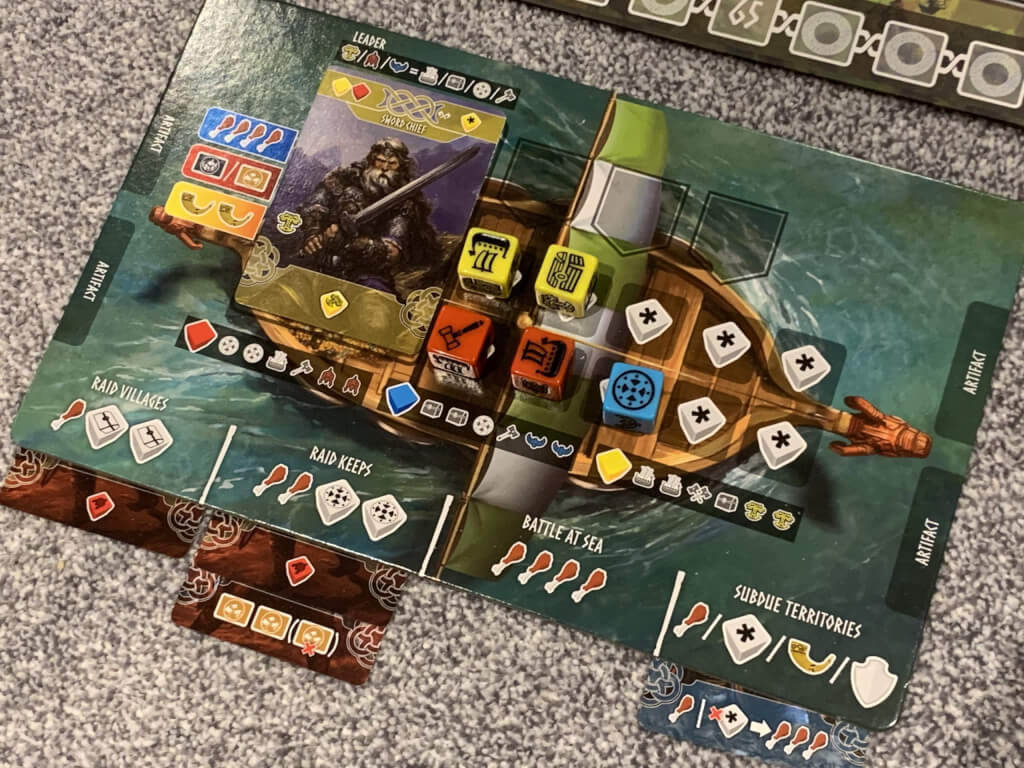
A more interesting example is the Trade With Villages action, which allows the first player to choose any three of several bonuses, including taking food, favour tokens, dice or a saga card. The second player may take two of these benefits, whilst the third and fourth may take only one — and in this case, resting is pointless, since the worst bonus the third or fourth player would receive from the space is three food.
As a side note, each player will also be adding reavers (which are basically crew members) to their player board as the game goes on, and four of the action spaces can trigger these crew members when chosen by any player. Reaver cards recruited to crew in this way will simply sit beneath the player board in the action slot chosen by the player, with just the benefit they provide showing.
These crew actions trigger as soon as an action space is chosen (before the action space itself resolves) and so for example, if each player has one or more reavers tucked under the Battle at Sea space, then when someone chooses that action, all of those reaver abilities are enabled at once. Broadly speaking, these benefits can be calculated and resolved at the same time — ie the first player might say “I need three blue dice and one red one” whilst the second might say “I get two food and a yellow die.” Timing can be an issue if two players need to draw bonus cards, but resolution then just reverts to turn order.
Now, because everyone gets bonuses (whether from the action space or resting) on every turn, Reavers of Midgard feels quite generous, to me. This is not the kind of stingy, super tight euro game where you’ll constantly be stroking your chin working out how to do things, it’s more a case of working out the optimal move from one turn to the next. What will score you the most glory? What will enable you to have a massive turn the next time round? Yes, you will sometimes need to knuckle down and take a lead action Trade With Villagers action, but once you have a few reavers generating bonuses for you, this becomes less and less necessary.
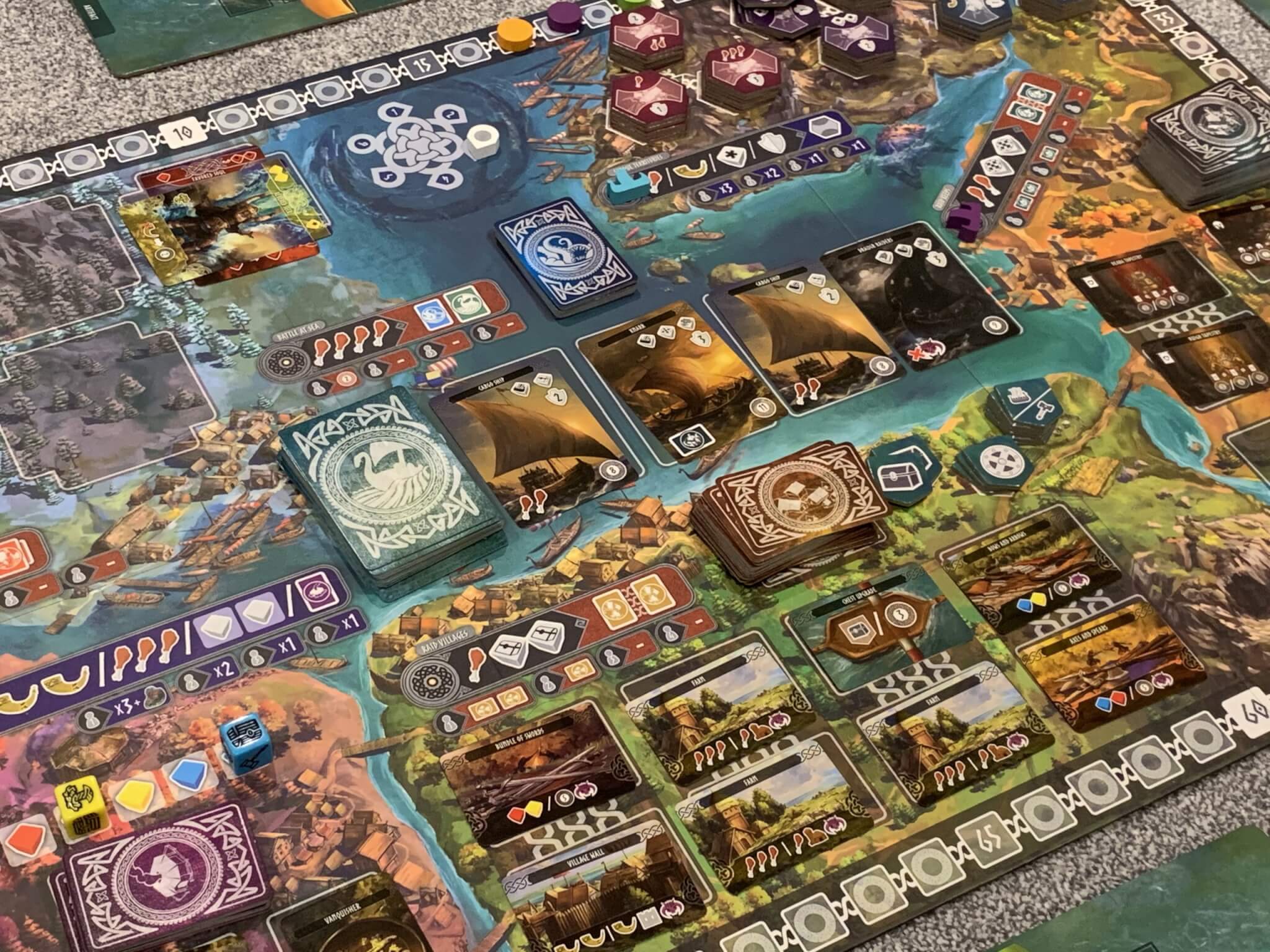
Similarly, this generosity corrects some of the problems that Champions of Midgard had, whilst simultaneously reducing the tension. In Champions, when players went to fight a sea monster, it was always tense and dice would be rolled — and lost — and there was a chance that battles could be lost before they even began based on randomly drawn journey cards. In Champions, food was also tighter and starvation could put a well-laid plan to the sword rapidly.
In Reavers, you’ll almost never have to worry about food, and therefore whilst starvation events can be drawn, you’ll rarely struggle to pay for them. Reavers also allows for players to pay for card resolution events in several ways, such as by combat (which works similarly to Champions, but isn’t quite as punishing) or by simply matching dice from your player board to the card in question. Favour tokens are now more abundant than the equivalent in Champions, and each favour token allows all dice to be rerolled, with no limit on how many favour tokens being spent.
This gives Reavers a more — and I hate to use the word because it sounds derogatory — perfunctory kind of feel. What I mean by that is that when you set out to do an action here, it is fairly rare that you will simply fail to achieve it, and instead, it’s more a question of how many resources will you need to spend in order to get the best possible outcome. Sea battles are probably the only exception, but even these feel so much less punishing than they do in Champions.
If the objective of the design for Reavers of Midgard was to make a heavier, euro-style alternative to Champions of Midgard, then I would call it a success. That said, in the shift to becoming a more mathematical puzzle with such a large amount of processing overhead from turn to turn, a fair bit of theme is lost. At no point whilst playing this game did I feel like a Viking, despite the heroic efforts of the art team, who really have made the game pop with colour and some fantastic drawings.
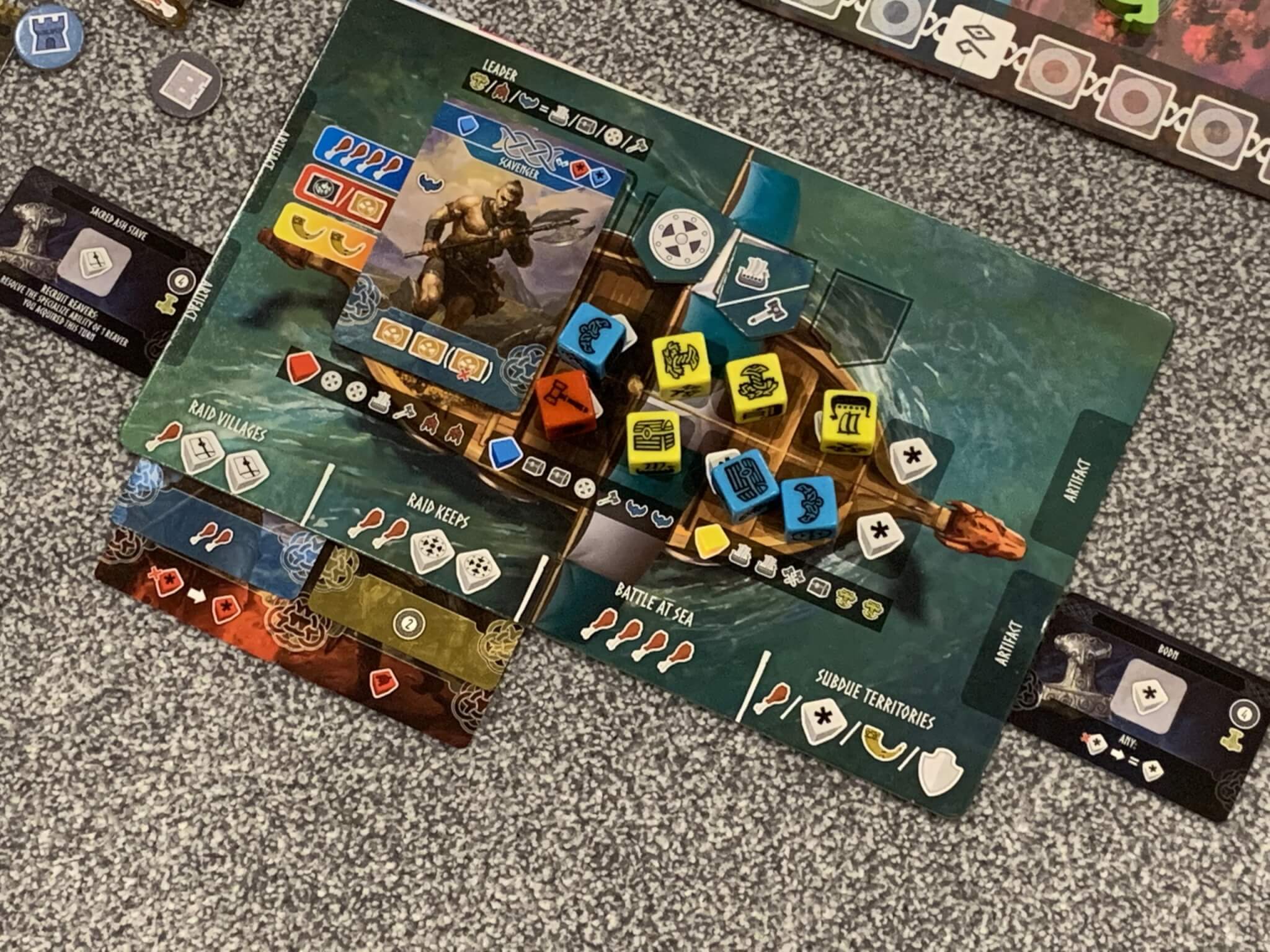
On the subject of the sheer mental processing power needed to comprehend this game and the apex point where that meets the artwork, I should also mention that there is a lot of iconography in this game, some of which is very small. The lack of a good visual glossary or a player guide is a miss here, and there are certainly going to be occasions where players need to squint at the board, or where they mistake one small deck of cards for another. This will improve with familiarity, but it’s tough on new players who are already struggling with the weight of the game.
All that said, Reavers of Midgard is a very good looking and well-produced game that works hard to draw the attention of anyone passing by the table. Aside from the boards, tokens, cards and bright artwork, onlookers will see that every player is fully engaged and immersed in the game — usually because they are calculating a sequence of moves and possibilities based on the best return on investing some number of resources into something, in order to get some number of points back.
Reavers of Midgard is not the best euro game you’ll ever play, I don’t think, but it is a big, attractive game that commits fully to its euro game brief and also works hard to integrate the Viking theme, even if the end result is more mathematical then thematic. New players interested in the theme would do better with Champions, I think, but those who played the original and liked the idea of the game but wanted something a little heavier should certainly look into Reavers of Midgard.
You can purchase Reavers of Midgard on Amazon.

Comments are closed.